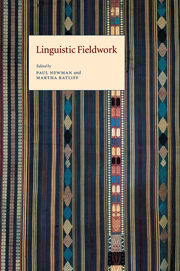Book contents
- Frontmatter
- Contents
- List of figures
- List of tables
- Notes on contributors
- Introduction
- 1 Fieldwork as a state of mind
- 2 Who shapes the record: the speaker and the linguist
- 3 Places and people: field sites and informants
- 4 Ulwa (Southern Sumu): the beginnings of a language research project
- 5 Escaping Eurocentrism: fieldwork as a process of unlearning
- 6 Surprises in Sutherland: linguistic variability amidst social uniformity
- 7 The role of text collection and elicitation in linguistic fieldwork
- 8 Monolingual field research
- 9 The give and take of fieldwork: noun classes and other concerns in Fatick, Senegal
- 10 Phonetic fieldwork
- 11 Learning as one goes
- 12 The last speaker is dead – long live the last speaker!
- Index
10 - Phonetic fieldwork
Published online by Cambridge University Press: 05 June 2012
- Frontmatter
- Contents
- List of figures
- List of tables
- Notes on contributors
- Introduction
- 1 Fieldwork as a state of mind
- 2 Who shapes the record: the speaker and the linguist
- 3 Places and people: field sites and informants
- 4 Ulwa (Southern Sumu): the beginnings of a language research project
- 5 Escaping Eurocentrism: fieldwork as a process of unlearning
- 6 Surprises in Sutherland: linguistic variability amidst social uniformity
- 7 The role of text collection and elicitation in linguistic fieldwork
- 8 Monolingual field research
- 9 The give and take of fieldwork: noun classes and other concerns in Fatick, Senegal
- 10 Phonetic fieldwork
- 11 Learning as one goes
- 12 The last speaker is dead – long live the last speaker!
- Index
Summary
Phoneticians typically distinguish three principal sub-disciplines within phonetics: these are concerned with how speech is produced, the nature of the sound itself, and how a human being reacts to speech stimuli. These first two areas are commonly referred to as articulatory (or physiological) phonetics and acoustic phonetics. The third encompasses auditory and perceptual phonetics; that is, it concerns both the way that the human auditory system works and the effects of various levels of further processing in the brain, in which a speaker's linguistic knowledge and experience play an important role. It is frequently difficult to separate auditory and perceptual effects since their investigation commonly relies on overt responses collected from listeners in which the sum of both kinds of processes is necessarily reflected.
A phonetic research project, whether in the field or in the laboratory, may be directed at investigating articulatory, acoustic, or auditory/perceptual facts alone. However, many studies consider the relationship between articulatory or auditory/perceptual facts and the acoustic layer which mediates between them. A naïve native speaker's sub-conscious phonetic knowledge about his or her language concerns only production and perception, and not acoustic properties, nor the strictly auditory processes which transform the acoustic signal. However, the articulatory organization of speech must succeed in encoding information in acoustic form, and the perceptual apparatus must succeed in extracting the information from the acoustic signal. Because a good deal is known about articulatory/acoustic relationships, an examination of acoustic patterns can provide indirect information on articulation.
- Type
- Chapter
- Information
- Linguistic Fieldwork , pp. 211 - 229Publisher: Cambridge University PressPrint publication year: 2001
- 30
- Cited by

